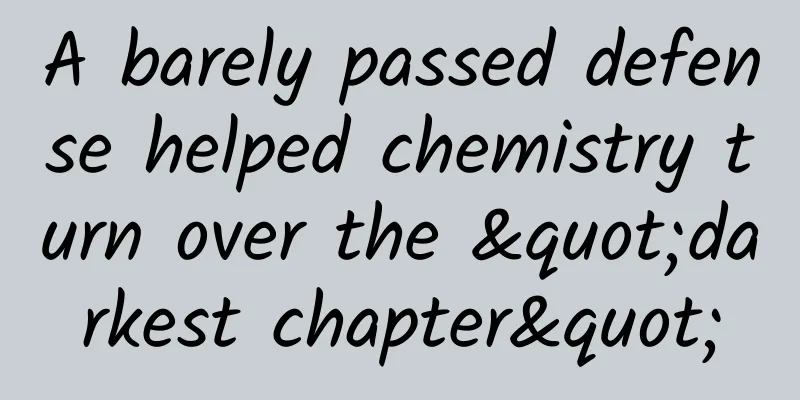A barely passed defense helped chemistry turn over the "darkest chapter"

|
German chemist Ostwald once lamented that the relationship between chemical reaction rate constant and temperature is complicated and is the "darkest chapter" of chemical kinetics. The Arrhenius formula opened a new chapter, and the concept of activation energy it established has far-reaching influence. The source of this achievement was a doctoral defense that barely passed. Written by Zheng Chao (Researcher at Shanghai Institute of Organic Chemistry, Chinese Academy of Sciences) This is the peculiarity of natural science: great men gradually become small, Because the new discoveries of successors always overshadow those of their predecessors. —Jacobs Henriques van't Hoff There are many types of chemical reactions, and the time scales vary greatly. When soda water is poured into lemon water mixed with phenolphthalein test solution, the solution immediately changes from colorless to pink, which shows that acid-base neutralization can be completed in an instant. Whether it is salted duck eggs from Gaoyou, Jiangsu, or ham from Jinhua, Zhejiang, it takes weeks or even months to taste the delicious pickled food. The remains of ancient organisms are deposited underground, and it takes millions or even hundreds of millions of years for coal and oil to form with geological movements. These facts clearly tell us that it is necessary to give chemical reactions the characteristics of "rate" to characterize how fast the amount of substances in the reaction changes over time. Chemical kinetics was born in the middle of the 19th century in response to this need and is still developing today. Marx believed that "a science can only be considered truly perfect when it successfully uses mathematics." Chemical kinetics introduced calculus into the study of chemical reactions for the first time, helping chemistry to become an exact science. However, interestingly, to this day, what kind of mathematical relationship should be used to appropriately describe such a complex object as "chemical reaction rate" is still a difficult problem facing chemists. Probability Game: The Law of “Mass” Action Chemical kinetics was born amidst many difficulties. The 19th century was an era of vigorous development of chemistry. The industrialization of major European countries, especially the rapid development of mining, metallurgy, pharmaceuticals, fertilizers, dyes and other industries, not only put forward urgent needs for the research and development and production of various chemicals, but also provided a broad stage for chemists to display their skills. But because of this, chemical research in the 19th century was full of pragmatism, and the focus of mainstream chemists' work was always on the discovery of new substances and new reactions. As for the exploration of the principles behind specific chemical reactions, it was secondary anyway. Of course, in an era when little was known about the microstructure of matter, we cannot demand that most chemists have the consciousness to quantitatively study the process of chemical reactions. On the other hand, the obstacles brought about by the lack of technical means cannot be ignored. Determining the kinetic behavior of a reaction requires real-time monitoring of the changes in the concentration of a substance in the system. In today's chemical laboratories, it is generally achieved by advanced in situ spectroscopy, a convenience that chemists more than a century ago could not imagine. In addition, it takes sufficient mathematical skills and intuition to dig out universal kinetic laws from raw experimental data. However, chemistry originated from ancient alchemy, and "dislike" for mathematics is the common instinct of almost all alchemists. In this way, the initial start of chemical kinetics must be inseparable from the stimulation from outside the discipline. Perhaps it was a coincidence, or perhaps it was "destined", the exploration of chemical kinetics kicked off with the "hobby" of the German "amateur" chemist Wilhelmy (LF Wilhelmy). In his early years, Wilhelmy ran a pharmacy in Pomerania (now Poland). At the age of 31, he gave up the business and went to many places in Germany to study, and finally obtained a doctorate from Heidelberg University. From 1849, he worked as a private lecturer (privatdozent) at his alma mater for five years, and then left the university to engage in private research. In 1850, Wilhelmy used a polarimeter to study the hydrolysis reaction of sucrose. Sucrose is the most common sugar substance in daily life. It will hydrolyze into glucose and fructose under acidic conditions. These three sugar molecules are chiral and can rotate the polarization plane of circularly polarized light penetrating their solutions. Among them, sucrose and glucose are right-handed, and fructose is left-handed, and its optical rotation value is much greater than that of glucose. Therefore, when a little acid is added to the sucrose solution, as the sucrose is hydrolyzed, the circularly polarized light penetrating the solution can be observed through the polarimeter from right-handed to left-handed. Wilhelmy was not the first person to study the hydrolysis of sucrose, but his research concept, which was different from that of general chemists at the time, helped him discover the mystery of chemical dynamics. Wilhelmy believed that the best way to study an unfamiliar phenomenon was not to immerse oneself in experimental observation, but to first assume a mathematical equation that describes the phenomenon, and then use experimental data to verify the correctness of the equation. This can not only avoid the blindness of the experiment, but also hope to obtain quantitative laws. Wilhelmy studied the "Analytical Theory of Heat" by the great French mathematician Fourier (J. Fourier) and got inspiration from the one-dimensional heat conduction equation. According to Fourier's theory, when the initial temperature distribution satisfies the cosine function, the rate of change of the temperature u at a certain point on the insulated rod with time t is proportional to the temperature at that point: By analogy with equation (1), Wilhelmy believed that the rate r of sucrose hydrolysis reaction can be defined as the rate of change of sucrose concentration [S] over time, and assumed that it is proportional to the concentration of sucrose: (2) where k is a rate constant that depends on the nature of the reaction. Solving this simple differential equation, we can see that the concentration of sucrose decreases exponentially with time in the reaction: Where [S]0 represents the concentration of sucrose at the initial moment of the reaction. With formula (3), Wilhelmy's observation of the sucrose hydrolysis reaction was no longer blind. He used the optical rotation value of the reaction system as a measure of the sucrose concentration. By recording the optical rotation values at different times, Wilhelmy quickly verified the correctness of formula (3)! Another person who came to a similar conclusion to Wilhelmy was the British AGV Harcourt. Unlike Wilhelmy, who had only five years of academic experience as a part-time lecturer, Harcourt was a prestigious professor of chemistry at Oxford University. He also had a loyal friend, mathematician W. Esson, who was also a professor at Oxford University. Harcourt and Esson were responsible for experiments and calculations respectively, and they collaborated on chemical kinetics for fifty years. The key to Wilhelmy's success, in addition to his genius in proposing equation (2), was the use of optical rotation values to indicate the concentration of sucrose. This method can achieve real-time observation without disturbing the hydrolysis reaction itself. Harcourt and Esson used the "iodine clock" reaction to solve the thorny problem of concentration measurement. The principle of the iodine clock reaction is very simple: hydrogen peroxide reacts slowly with potassium iodide solution to produce iodine, which can react with baking soda to be quickly removed; and the most notable feature of iodine is that it turns blue when it encounters starch. If a small amount of starch and baking soda is added to the beaker of the reaction of hydrogen peroxide and potassium iodide in advance, the iodine produced by the reaction must wait until all the baking soda is consumed before it can accumulate in the beaker, and then react with the starch to turn the solution blue. At this time, if the same amount of baking soda is added, the blue color of the solution will fade quickly because the iodine is removed, and it will not recover until the newly added baking soda is completely consumed. Repeatedly, the blue color in the beaker continues to appear/fade, forming a beautiful iodine clock. It naturally indicates the rate of reaction between hydrogen peroxide and potassium iodide. The biggest challenge of the iodine clock reaction operation is how to accurately record the moment when the solution changes color. According to the description in Harcourt's 1866 paper, this requires a trained observer to look at the solution, put his ear close to the clock, count the ticking of the second hand in his mind, and record the seconds that have passed when the solution changes color. With this slightly crude method, Harcourt was able to record time intervals ranging from a few seconds to tens of seconds (even estimated to 0.01 seconds), and made amazing discoveries. As hydrogen peroxide is consumed, the interval between two blue changes in the solution gradually lengthens. Plotting the amount of remaining hydrogen peroxide against the reaction time yields an exponential decay curve. The formula derived by Essen is completely equivalent to Wilhelmy's formula (3). Figure 1. Wilhelmy's paper on sucrose hydrolysis (left) and Harcourt and Essen's paper on the iodine clock reaction (right). The blue line marks the formula for the exponential decrease of reactant concentration over time. Image source: Annalen der Physik und Chime 1850, 81, 413. (left) J. Chem. Soc. 1867, 20, 460. (right) Equations (2) and (3) discovered by Wilhelmy and Harcourt/Essen actually give the kinetic characteristics of a pseudo-first order reaction, that is, the reaction rate is proportional to the concentration of a single reactant. By "slightly generalizing" equation (2), we can guess that for a reaction of the form The rate of the elementary reaction (expressed as the rate of change of the concentration of the product P) should be proportional to the power of the concentration of all reactants, with the stoichiometric number of the reactants as the exponent: In the commonly used textbooks of "General Chemistry" and "Physical Chemistry", equation (5) is called the Mass Action Law, and its proposers are generally attributed to P. Waage, a chemist at the University of Oslo in Norway, and his brother-in-law, CM Guldberg, a mathematician. However, thoughtful students will inevitably question: Equation (5) clearly talks about the relationship between the concentrations of various substances, so where does the term "mass action" come from? CM Guldberg (left, 1836-1902) and P. Waage (right, 1833-1900) In fact, the process of generating equation (5) is quite complicated and is by no means a simple generalization of equation (2). When Wager and Gudberg published their first paper in Norwegian in 1864, they did not know about Wilhelmy's results (the value of Wilhelmy's work was not recognized until the 1880s by the German chemist FW Ostwald), and Harcourt and Essen's paper had not yet been published. The starting point for Wager and Gudberg's study of chemical reaction processes was a traditional concept called "affinity" or "chemical force". Limited by the lack of understanding of the microstructure of matter and out of "imitation" of macroscopic mechanics, as late as the middle of the 19th century, many chemists still believed that chemical reactions were driven by some kind of "force". The magnitude of the affinity between different substances determines the direction and degree of the chemical reaction. Wager and Gudberg wanted to quantify this affinity. The object of their study was the reversible reaction consisting of the esterification of carboxylic acids with alcohols and the hydrolysis of esters. At that time, people already knew that reversible reactions would eventually reach the same "equilibrium" state no matter which side they were started from. Wager and Goldberg believed that this equilibrium meant that the affinity of the forward and reverse reactions was equal (just like the static equilibrium of macroscopic objects). Consider the form For a general reversible reaction, the affinity balance can be expressed as That is, affinity is proportional to the power of the reactant concentration (α and α′ are unknown coefficients). Wager and Goldberg always called the substance concentration in equation (7) "active mass", which is the origin of the name "mass action". This naming preference probably comes from the persistent belief that "force should act on mass". Wager and Goldberg's ideas are not rigid. At first, they believed that the power exponents p and q in equation (7) must be determined experimentally, but later they admitted that in some cases they can be replaced by the stoichiometric numbers a and b in equation (6). At the same time, they claimed that the reaction rate is also related to affinity, so the law of mass action expressed by equation (5) has taken shape. The affinity that can "drive" chemical reactions is, of course, fictitious. As Ostwald criticized, the concept of affinity has not contributed to the development of chemical kinetics, but has only harmed it. However, the correct path to understanding chemical kinetics from a microscopic perspective cannot be the "energeticism" advocated by Ostwald, but rather statistical mechanics based on molecular kinetics. The first person to explain chemical reactions from the perspective of molecular motion was L. Pfaundler, a physicist at the University of Innsbruck, Austria. In his 1867 paper, he clearly stated that chemical reactions are triggered by molecular collisions, and the higher the collision frequency, the faster the reaction rate. Once such a view is established, the law of mass action is almost a natural conclusion. We can regard the concentration of a substance as the probability of finding a molecule of the substance at a certain point in the reaction container space. If the spatial distribution of each substance is independent of each other, then according to the basic principles of probability theory, the probability of a molecular collision event can be written as the product of the power of the substance concentration (with the stoichiometric coefficient as the exponent), and the rate constant k in equations (2) and (5) can be roughly understood as the frequency of "effective collisions" that can trigger chemical reactions. As the most critical parameter for describing the kinetic properties of chemical reactions, the measurement and analysis of the rate constant k naturally becomes the core issue in chemical kinetics research. Unraveling the mystery: Arrhenius formula In most cases, increasing the temperature can accelerate chemical reactions. This is easy to understand from the perspective of molecular motion, because temperature is a measure of the average speed of molecular motion. When the speed of motion increases, the probability of molecular collision and even chemical reaction will naturally increase. However, physical chemists will not be satisfied with simple qualitative descriptions, but try to measure the rate constant k of a given chemical reaction at different temperatures T, hoping to establish a quantitative dependence between k and T. Although there were continuous research results in this area in the second half of the 19th century, the answers they could give were far less than the confusion they brought. People found that if ln k is used as the fitting target, it is sometimes proportional to T, sometimes proportional to ln T, and sometimes proportional to -1/T. Even the linear combination of these three temperature terms can often improve the accuracy of the fitting! The coexistence of many different forms of k ~ T equations makes it difficult to believe that there is a simple and universal mathematical relationship between rate constants and temperature. No wonder Ostwald lamented that the study of the relationship between rate constants and temperature is the "darkest chapter" of chemical kinetics. Table 1. Various equations for chemical reaction rate constant k and absolute temperature T Source: J. Chem. Educ. 1984, 61, 494. The main reason for this situation is that the temperature range that the kinetic experiments could cover at that time was very narrow. If the experimental temperature is set to 0 ~ 50 degrees Celsius, the variation (calculated in absolute temperature) is only 20%. At this time, T, ln T and -1/T are close to a linear relationship. Therefore, even if the same set of kinetic experimental data is used, it is entirely possible to fit different k ~ T equations. In other words, if the physical image behind the equation is not explored in depth, and the quality is only evaluated by the fitting accuracy, then the exploration of the k ~ T relationship will definitely lose its direction. Harcourt, who has been immersed in the study of reaction rates for half a century, placed his hopes on young people, hoping that chemists can reap the joy of measuring the pace of time like astronomers predicting occultations. Fortunately, this puzzle did not wait too long before its solver: the twin stars of physical chemistry - Dutchman JH van 't Hoff and Swede S. Arrhenius. Left: JH van 't Hoff (1852~1911), winner of the 1901 Nobel Prize in Chemistry; Right: S. Arrhenius (1859~1927), winner of the 1903 Nobel Prize in Chemistry Van't Hoff and Arrhenius were of similar age and had many similarities in their academic experience. They both made epoch-making achievements during their doctoral studies, but were not recognized by the "authority" and were even ruthlessly attacked. In 1874, Van't Hoff first proposed the "tetrahedral" structure hypothesis of carbon atoms to explain the optical rotation phenomenon of chiral substances. However, this idea was too advanced and difficult to be accepted by the mainstream organic chemistry community at the time. German chemist H. Kolbe even satirized Van't Hoff's wild imagination and said that he was worthy of the position of lecturer at the Utrecht Veterinary College. After that, Van't Hoff went to work at the University of Amsterdam and the University of Berlin, turning his research interests to physical chemistry, and made pioneering contributions in chemical equilibrium and kinetics, osmotic pressure theory, etc. In 1884, Van't Hoff published the book "Chemical Kinetics Research", which viewed chemical equilibrium from the perspective of thermodynamics, paving the way for the final elucidation of the law of change of rate constant with temperature. It is a very natural idea to solve temperature-related problems from the perspective of thermodynamics. Moreover, in the second half of the 19th century, macroscopic thermodynamics had developed to a fairly complete level. However, the sophisticated concepts and formulas of thermodynamics were not created for the study of chemical reactions. Interdisciplinary knowledge transplantation requires a suitable opportunity. The first person to embark on this path was the German Horstmann (A. Horstmann), who discovered in 1873 that the process of decomposition of solid ammonium chloride to produce gas (ammonia and hydrogen chloride) and the process of evaporation of liquid to produce gas obey the same thermodynamic laws. Horstmann borrowed the idea of entropy in thermodynamics to describe the relationship between pressure p, temperature T and reaction heat q in solid gas production reactions. Where R is the universal gas constant. It should be pointed out that the strict theory of chemical thermodynamics was proposed by JW Gibbs of Yale University in the United States, but Gibbs's ideas were almost ignored in the European chemical community in the 1880s. Van't Hoff extended Horstmann's conclusion to general chemical equilibrium and replaced the pressure p in equation (8) with the equilibrium constant K of the chemical reaction: Equation (9) is generally referred to as the "Van't Hoff isotherm equation". At the same time, Van't Hoff no longer regarded chemical equilibrium as a static equilibrium of affinity, but believed that the forward and reverse reactions were still ongoing under equilibrium conditions, and that the reaction rates were exactly equal (Van't Hoff was the first to use a double-headed arrow instead of an equal sign to represent a reversible reaction, and this notation is still used today). Therefore, the equilibrium constant K can be written as the ratio of the forward and reverse reaction rate constants k1 and k–1 (K = k1/k–1). Substituting this relationship into equation (9), we get: The next step is the most imaginative one. Van't Hoff decomposed the heat of reaction q into the difference between two "energies" (q = E1 – E–1), so equation (10) can be further rewritten as If we boldly omit the subscripts representing the forward and reverse reactions, we can get At this point, Van't Hoff derived a simple relationship between the rate constant and temperature - "ln k is linearly related to -1/T" stands out from many candidates - the premise is that the value of E in equation (12) is independent of temperature. Interestingly, in most "General Chemistry" and "Physical Chemistry" textbooks, equation (12) is not named after Van't Hoff, but is called the "Arrhenius formula". The most likely reason behind this is that this close friend of Van't Hoff was the first to interpret the meaning of the mysterious energy term E in equation (12). In his early years, Arrhenius studied at Uppsala University and Stockholm University in Sweden. In his doctoral thesis, he proposed the theory of ionization of aqueous electrolyte solutions. This unorthodox theory caused Arrhenius to only get a third-class grade (Cum Laude) in the defense, and he almost failed to pass the degree defense. After the thesis was published, it was also sharply criticized (there were many famous chemists such as DI Mendeleyev who opposed the ionization theory). However, Arrhenius did not give up his theory. Instead, he sent the thesis to Ostwald, van't Hoff and others, and successfully won their appreciation. Ostwald even traveled thousands of miles to Sweden to discuss the ionization theory with Arrhenius in person, and invited Arrhenius to teach at the Riga Technical University where he worked. Thanks to the support of the "international" academic community, Arrhenius obtained the position of associate professor of physical chemistry at Uppsala University at the end of 1884. In the nearly ten years that followed, Arrhenius traveled to various parts of Europe. Around 1885, he conducted a brief collaborative research with Van't Hoff in Amsterdam. Arrhenius applied the ideas derived from ionization theory to chemical reactions and proposed the concept of "activation energy (Ea)" in 1889, which eventually led to the Arrhenius formula being finalized as where A is the temperature-independent pre-exponential factor. Electrolytes are substances that conduct electricity in molten state and in aqueous solution, like salt. Chemists since Faraday have explained the conductivity of electrolyte solutions as the decomposition of "sodium chloride molecules" in salt water by an applied current, producing positively charged sodium ions and negatively charged chloride ions, which move to the cathode and anode, respectively. This is also the original meaning of the word "electrolysis". After carefully studying the conductivity of electrolyte solutions, Arrhenius proposed that the decomposition of sodium chloride is not the result of electricity, but is completely carried out when it is dissolved in water (the inability to understand the spontaneity of the separation of positive and negative charges during the electrolyte ionization process is the main reason why the degree review professors gave Arrhenius a "bad review"). For weak electrolytes such as acetic acid, Arrhenius believed that only a small part of the "activated" acetic acid molecules were ionized (releasing hydrogen ions and acetate anions) and contributed to the conductivity of the solution. Arrhenius used the same idea to look at chemical kinetics. Taking the hydrolysis reaction of sucrose as an example, according to statistical mechanics, the movement speeds of a large number of sucrose molecules at a given temperature are not the same and obey the Maxwell-Boltzmann distribution. The exponential term exp(–Ea/RT) in formula (13) has the mathematical form of the Boltzmann factor, which represents the proportion of sucrose molecules with energy higher than Ea at temperature T. Arrhenius believed that only this part of "activated" sucrose molecules can react. Activated sucrose and ordinary sucrose exchange energy through collision and are in dynamic equilibrium. When the temperature rises, the proportion of activated sucrose increases significantly, and the rate of hydrolysis reaction also accelerates. Ea is the minimum energy threshold that activated sucrose should have, and activation energy is a very appropriate name. The pre-exponential factor A in formula (13) represents the limiting rate constant of the hydrolysis reaction when Ea = 0 (all sucrose molecules are in an activated state). Figure 2. Van't Hoff (left) and Arrhenius (right)'s discussion on the relationship between rate constants and absolute temperature. The blue line marks Van't Hoff's formula for ln k and Arrhenius' discussion on activated sucrose. Image source: Etudes de dynamique chimique, Amsterdam, 1884. (Left) Zeitschrift für Physikalische Chemie 1889, 4, 226. (Right) After Van't Hoff and Arrhenius's careful analysis, they found a simple mathematical relationship between the rate constant k and the temperature T, which is supported by physical images. Although the requirement that the pre-exponential factor A and the activation energy Ea must be independent of temperature is somewhat rigid and inconsistent with many experimental results, the Arrhenius formula is still loved by physical chemists. Fifty years after the publication of Van't Hoff's Chemical Kinetics, M. Polanyi of Manchester University in the UK and H. Eyring of Princeton University in the United States proposed the famous "transition state theory" (also known as the activated complex theory and the absolute rate theory). Based on the concept of potential energy surface and starting from the molecular partition function, they derived the expression of the elementary reaction rate constant (Eyring formula). The mathematical form of the Eyring formula is very similar to the Arrhenius formula. The energy E0 in its Boltzmann factor exp(–E0/RT) is interpreted as the difference between the potential energy of the transition state structure and the reactant. The macroscopic experimental phenomenon of “ln k is linearly correlated with –1/T” finally found a theoretical basis at the microscopic level of molecular structure. After years of experience, Van't Hoff and Arrhenius gradually grew from young people who were not recognized by the authority to respected senior scientists. Especially Arrhenius, he not only served as a professor and president of Stockholm University, but also deeply participated in the execution of Nobel's will and the nomination and selection of the Nobel Prize. In 1901, Van't Hoff won the first Nobel Prize in Chemistry for his contribution to the theory of osmotic pressure and chemical equilibrium. Arrhenius himself also won the Nobel Prize in Chemistry in 1903 for proposing the ionization theory. Although there are always criticisms that Arrhenius used the Nobel Prize for private purposes, gave it privately, and even prevented his opponents from winning the prize (possible victims include Mendeleev, German Nernst (WH Nernst) and others), Van't Hoff and Arrhenius participated in the establishment of physical chemistry, especially the contribution of developing the theory of chemical kinetics, which will not be forgotten by future generations. To be continued In the history of chemical kinetics, defining the reaction rate constant k and establishing the Arrhenius equation can only be regarded as the first step in a long journey. How to establish a quantitative structure-activity relationship between the properties of complex organic molecules and reaction kinetics is the goal pursued by younger physical organic chemists, and is also an excellent guide for leading organic synthetic chemistry into the era of big data and artificial intelligence... Acknowledgements The authors would like to thank Academician You Shuli, Researcher Li Zhanting from the Shanghai Institute of Organic Chemistry, Chinese Academy of Sciences, Researcher Cao Zexian from the Institute of Physics, Chinese Academy of Sciences, Researcher Tian Wenming from the Dalian Institute of Chemical Physics, Chinese Academy of Sciences, and Professor Yang Zhongyue from Vanderbilt University for their valuable comments on this article. About the Author Dr. Zheng Chao is a researcher at the Shanghai Institute of Organic Chemistry, Chinese Academy of Sciences, and a recipient of the National Natural Science Foundation of China Excellent Young Scientist Fund Project. His research interests are physical organic chemistry and chiral synthesis. References [1] EA Guggenheim, J. Chem. Educ. 1956, 33, 544. [2] E. Farber, Chymia 1961, 7, 135. [3] E. W. Lund, J. Chem. Educ. 1965, 42, 548. [4] PW Andersen, Science 1972, 177, 393. [5] J. Shorter, J. Chem. Educ. 1980, 57, 411. [6] MC King, Ambix 1981, 28(2), 70. [7] MC King, Ambix 1982, 29(1), 49. [8] KJ Laidler, J. Chem. Educ. 1984, 61, 494. [9] KJ Laidler, Arch. Rational Mech. 1985, 32, 43 [10] MH Abraham, J. Phys. Org. Chem. 1994, 7, 655. [11] X.-K. Jiang, Acc. Chem. Res. 1997, 30, 283. [12] F. Dyson, Nature 2004, 427, 297. [13] J. Quílez, Bull. Hist. Chem. 2006, 31, 45. [14] G. Nagendrappa, Resonance 2007, 12(5), 21. [15] J. Mayer, K. Khairy, J. Howard, Am. J. Phys. 2010, 78, 648. [16] J. Quílez, Found. Chem. 2019, 21, 221. [17] J. Quílez, Found. Chem. 2021, 23, 85. [18] BJ Shields, J. Stevens, J. Li, M. Parasram, F. Damani, JIM Alvarado, JM Janey, RP Adams, AG Doyle, Nature 2021, 590, 89. [19] E. Callaway, Nature 2022, 608, 15. [20] MH Back, KJ Laidler, Ed. Selected Readings in Chemical Kinetics. Pergamon Press, 1967. [21] P. Coffey, Cathedrals of Science: The Personalities and Rivalries That Made Modern Chemistry. Oxford Academy Press, 2008. [22] T. Hey, S. Tansley, K. Tolle, Eds. The Fourth Paradigm: Data Intensive Scientific Discovery. Microsoft Research, 2009. [23] NE Henriksen, FY Hansen, Theories of Molecular Reaction Dynamics, The Microscopic Foundation of Chemical Kinetics, 2nd Ed. Oxford University Press, 2019. [24] H. Westheimer, A Biographical Memoir of Louis Plack Hammett, National Academy Press, 1997. [25] Gregory D. Walcott and Jiang Xiaoyuan, eds., A Source Book in Chemistry, Chinese Publishing House, 2022. [26] Chen Minbo, Science Bulletin, Vol. 79, No. 3, 2016, p. 196. [27] Zhao Kaihua, Qualitative and Semi-quantitative Physics (Second Edition), Higher Education Press, 2008. [28] Y. I. Soloviev and H. A. Figurovsky, Arrhenius: Life and Activities, translated by Ding You, Commercial Press, 1965. [29] Li Zhanting, Famous Chinese Scientists of the 20th Century: Jiang Xikui, Jincheng Publishing House, 2008. Special Tips 1. Go to the "Featured Column" at the bottom of the menu of the "Fanpu" WeChat public account to read a series of popular science articles on different topics. 2. Fanpu provides a function to search articles by month. Follow the official account and reply with the four-digit year + month, such as "1903", to get the article index for March 2019, and so on. Copyright statement: Personal forwarding is welcome. Any form of media or organization is not allowed to reprint or excerpt without authorization. For reprint authorization, please contact the backstage of the "Fanpu" WeChat public account. |
>>: Can content generated by AI be used as you wish?
Recommend
Interface testing practice | What to do if the higher version of Android cannot capture HTTPS
In interface testing, I believe many people have ...
How to create exclusive brand day operation activities?
How to design a good operation plan ? It is essen...
Read "The Demonic Daddy in the City" for free, and watch the finale of "The Demonic Daddy in the City" by Ye Chen for free!
Five years ago, Ye Chen was thrown into the river...
Google releases second Android 13 developer preview to improve notification push permission settings
In recent months, the development of Android 13 h...
Cool Money Taobao Blue Ocean paid articles
Introduction to the paid articles resources of Ku...
50 questions about Douyin influencer promotion!
50 questions about Douyin influencer promotion ! ...
Essential knowledge for Android development: I have a date with Gradle
0. Tell a story 0.1 Ant, I really thought you wer...
The latest policy on Beijing’s passenger car quota in 2022: What is the personal new energy quota?
As the capital of our country, Beijing is the cit...
World Love Beans Day! Beans, how come you are so outstanding?
February 10th is the fifth "World Pulses Day...
5 angles to make high-traffic Tik Tok videos!
There are two main points to focus on when doing ...
Jia Yueting announced that Ulrich Kranz, the "Father of BMW i Series", joined FF as CTO
According to Faraday Future's official website...
The official version of iOS 17.0.3 is released, and the heating problem is finally solved!
iOS 17.0.3 official version released This morning...
Second-tier e-commerce marketing | Secrets to creating hot-selling products in the jewelry and watch industries!
In the past two years, jewelry, accessories and w...
Don't buy these 3 kinds of toothpaste, or they may cause cancer
Expert of this article: Huang Lu, Director of Hel...
The competition among home appliance enterprises has entered the second half, and the trend of smart home appliances has arrived
With the popularization of cloud computing, big d...









